“One of the biggest factors in success is the courage to undertake something”- James A Worsham
Critical Success Factors: Overview
The world is brimming with examples of how some ambitious people pursued their entrepreneurial dreams and emerged as industry leaders. We have literally seen dreams translate into reality because of excellence and hard work. From Mark Zuckerberg, Jeff Bezos, Elon Musk to Oprah Winfrey, there is a plethora of inspirational stories to look up to! What do you think is the most common thing about such enchanting stories? The answer is simple, they always believed in their abilities more than they ever entertained the thought of quitting. Besides believing in themselves, they have also been excellent at decoding the critical success factors.
Table of Content
Success is an immensely powerful notion and that is something all of us acknowledge without any discord. Another proven fact about success is that success does not come overnight or within a span of a few days. Success is a constant journey that people undertake and the destination remains indefinite. After all, you do not want to bound the idea of your success to any limits, do you? When it comes to success and growth, the more the merrier is the only mantra! What makes an individual or organization successful are some critical success factors that drive positive outcomes.
This thoughtful and intelligible blog puts forth an elucidation of critical success factors in business and explains in an intriguing manner how each of these factors is highly significant. Moreover, for better contemplation and practical understanding, we have classified the critical success factors into different types that blend together for the progression of a business.
Also, umpteen examples of critical success factors in business are presented. To begin with, let us shed light on the definition of critical success factors.
Critical success factors Definition
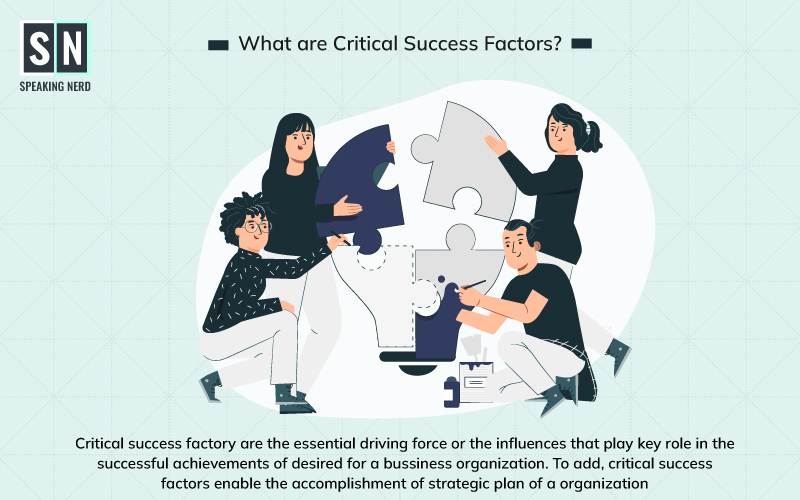
Although the term critical success factor is quite self-explanatory, it is imperative to glance at a more elaborate definition of the concept. As we know, goal setting is a vital process in the context of every organization. Business leaders and top executives often engage in setting strategic goals for their organizations that are directly linked to expansion, business diversification, higher profitability, enhanced revenue growth, and so on. This goal setting helps business leaders visualize the magnitudes of advancement and success that they would want their company to achieve.
Now, what do you think is the most important thing when it comes to the accomplishment of these goals inspired by the vision and mission of an organization? Of course, there are some imperative influences or driving forces linked to the successful achievement of each strategic goal. This is where critical success factors come into the picture. Critical success factors are the quintessential driving factors of success that organizations need to prioritize in order to achieve desired outcomes.
In other words, critical success factors can also be defined as action statements that the top management along with the employees within an organization need to lay great emphasis on to reach the target goals. Organizations need to pursue these factors in an incessant manner to scale new heights of success. On the other hand, when these action statements are ignored, the gap between the current state and the desired state begins to widen and growth may get stalled.
Probing further, when critical success factors collaborate with the strategic plans that a company envisages for the next set of years, the scenario enables better development of strategic objectives. Having critical success factors within sight can facilitate great clarity on what objectives are of utmost importance under various strategic goals.
Let us consider an example here for a more lucid understanding. As per the Bureau of Labour Statistics, the annual employee attrition rate in the US is 57.3 percent. Besides, as per Forbes, US firms lose up to 33 percent of an employee’s annual salary in the replacement of an outgoing employee. For small businesses, certainly, the cost of employee turnover can be shattering. So, let’s say a firm in the US creates a strategic plan to pull down the employee turnover rates to 35 percent in the next two to three years.
Now, what do you think are going to be some critical success factors intrinsic to this strategic goal? What are the success factors that are needed to be implemented so that employees stay in the firm for the longest? Employee engagement, motivation, sense of belonging, employee wellness, appreciation, and rewards are some key success factors for low employee turnover. After realizing these critical success factors, the firm can further set more specific objectives for meeting the goal. In case any critical success factor goes neglected, it can affect the desired results.
The key to success hence lies in developing the right critical success factors and developing them in an efficient manner. Needless to say, the better the realization of the critical success factors the more productive will be the implementation of strategic planning. Having said that, the ensuing section presents details on the best practices of developing critical success factors for further driving humongous business success.
How to develop critical success factors (CSFs)
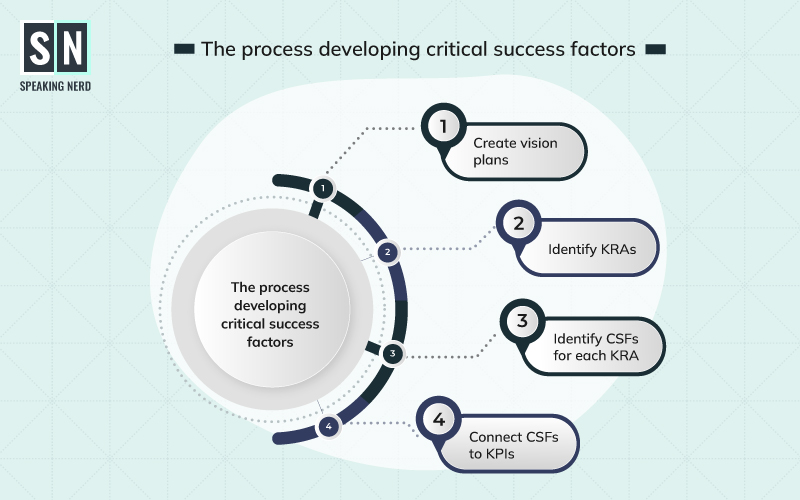
The process of identifying and developing critical success factors in a thoughtful manner is illustrated below in terms of vital steps in a specific order.
1. Create vision-based strategic plans
Strategic planning is the starting point for developing critical success factors. It is important to note here that before developing the critical success factors, it is essential to create strategic plans. Thereafter, coherent to strategic plans and goals, the key areas have to be identified satisfactory results which will determine business success.
Every company has its own vision and mission statements that inspire strategic planning at all levels. If we talk about strategic planning, it defines the course of action of a business over the next three to five years in the usual sense. This is where the difference between strategies and tactics is important to decipher.
Strategies imply long-term objectives that individuals or businesses set for themselves. On the other hand, tactics are smaller objectives that are to be met in short spans of time for a strategy to succeed. In other words, a strategy is an integration of multiple tactics.
Therefore, before developing CSFs, a company’s top management needs to be clear of what strategic plans it wants to work on in the near future. In this way, strategic planning gives a sense of direction to an organization which is vital to the cause of setting strategic goals. Business leaders first need to establish what they want their business to achieve in the course of the next two to three years.
Let’s take the example of Infosys here. The vision statement of Infosys states that it aspires to be a globally renowned business providing the best solutions and leveraging technology in the best way. Further, the company’s mission is to achieve its objectives in an environment that is built on fairness, honesty, and courtesy for all employees, vendors, and clients. Based on the same, the company had set a strategic goal in 2020 to increase the number of native Americans in its US workforce.
The company has committed to building a workforce of 25000 American employees in the next four to five years. The company is strategically focusing on creating more and more jobs in the US. Now that the company has well-defined strategic goals, it can further identify the result areas and success factors.
2. Recognize the key result areas (KRAs)
As hinted above, the next step after strategic planning is to recognize the areas where positive results are desired such that strategic plans can advance. Strategic plans are to be pursued over a course of years, unlike tactics that are short-term in nature. Having said that, strategic planning is based on extensive frameworks of interconnected dimensions.
Business leaders need to determine the areas that are of maximum importance and relevance to strategic goals. To identify the KRAs, it is essential to review strategic plans, discuss them with all stakeholders and deliberate on the processes that are to be carried out to make plans work. Further, the recognition of imperative processes will facilitate the identification of the areas where effort and resources need to be invested.
Moreover, Great results in these areas will have a direct implication on the success of strategic goals. It is crucial to be able to effectively ascertain the key areas with which an organization’s performance needs to be aligned.
To exemplify, acquisition of talent, employee engagement, talent management, and performance management are some common key result areas for the HR department of every organization. In a similar way, different strategic goals of a business and different verticals have their own specific KRAs.
3. Identify CSFs for every KRA
From the purview of developing critical success factors, this is the most imperative step. After business leaders and stakeholders have established the KRAs, specific CSFs need to be defined for each of them. As explained in the definition of critical success factors, these are the driving forces that need to be given the required attention and momentum for a business to succeed in its visionary goals.
Each KRA that is coherent to the strategic plans and goals of an organization will have its set of unique critical success factors. To explain, the critical success factors linked to marketing KRAs will be completely different from the KRAs of customer service. Similarly, the KRAs in the manufacturing industries will be largely in contrast with the KRAs in the media industry.
Let us take a more realistic and pragmatic example here to understand the correlation between KRAs and CSFs. In manufacturing, operational costs are among the most prominent key result areas from the production point of view. Of course, every manufacturing business aims for low operational costs as that would increase the profit margins.
Now, one of the most critical success factors pertaining to the KRA of operational costs will be production efficiency. If the production efficiency will be high, operational costs will be low and profitability will be higher. In this way, the CSF of production efficiency will prove to be sacrosanct to the strategic goal of boosting profitability. This example has made the connection between KRAs and CSFs crystal clear, isn’t it?
Key Point: It is essential to note that it is highly recommended to keep the number of CSFs in each KRA down to five or seven. An optimum number of critical success factors is vital so that there is a streamlined focus on each of them for enhanced success. Besides, it ensures that each CSF has a massive impact and there is a clearer sense of direction going into each strategic project. A large number of CSFs on the other hand can cause a mixing of objectives and avoidable confusion.
4. Designate KPIs to success factors
The development of critical success factors is not worthwhile unless these factors are connected to relevant key performance indicators (KPIs). KPIs make the critical success factors measurable in a quantifiable way and also make them more actionable. In the absence of KPIs otherwise, how would business leaders gauge how well their company is doing to deliver on the CSFs in each KRA.
The key performance indicators will play a pivotal role in measuring a company’s progress in terms of leveraging critical success factors to meet strategic goals. The quantifiable data rendered by these metrics will be invaluable in reassessing objectives, identifying new key result areas, and tracking each CSF.
For instance, let’s say the strategic goal of a company is to build a strong internet presence to generate more leads. Some of the imperative KRAs here would be content marketing and social media marketing. Now let us consider the domain of content marketing here and identify its CSFs. Probing further, one of the critical success factors of content marketing is search engine optimization (SEO). Furthermore, the number of backlinks, organic traffic, branded traffic etcetera are key performance indicators that are critical to tracking the efficiency of SEO practices. When developing KRAs, it's important to work with marketing experts who understand the best practices for lead generation, blogging, and digital advertising.
This example explains how KPIs are salient for tracking the critical success factors and provide quantitative insights into the progress around CSFs. As KPIs provide real insights, companies can keep improving on their strategies and actions to leverage critical success factors in a better way.
In the next section, we present elucidation of the different types of critical success factors in business. Based on whether certain success factors are connected to the prerequisites of specific industries, environmental influences, or other parameters, they have been classified into different segments.
Types of critical success factors
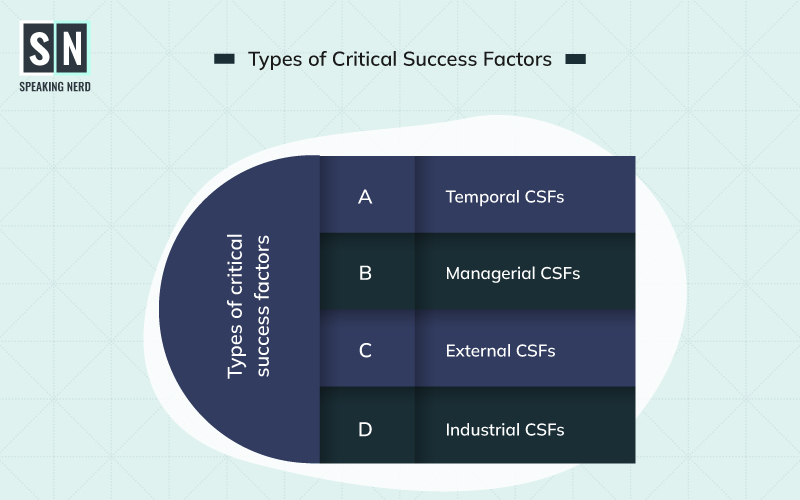
1. Temporal CSFs
As the term suggests, these are short-term critical success factors that are temporary in nature. However, that should not make us believe that they carry little or no importance. Indeed they are highly imperative for the success of strategic objectives and hence qualify to be critical success factors
Moving forward, the temporal critical success factors do not have a permanent influence on the performance of growth of a business. These CSFs are more situational or circumstantial in nature. Identifying the temporal success factors and implementing these factors effectively can ensure business continuity in unusual times.
Let us take the example of the ongoing COVID-19 pandemic here that came across as something bizarrely unprecedented. As we know, because of the pandemic, a lot of businesses had to temporarily shift to telecommuting amid lockdowns to ensure that business continuity is maintained.
Therefore, all the critical success factors that the companies had to pay heed to in order to make remote communications and collaboration effective were more temporal in nature. Now for the companies who have returned back to their brick and mortar office setups, the CSFs of telecommuting are of little value.
2. Managerial CSFs
These are the critical success factors that are not pertinent to the entire organization but only to the people in managerial positions. As we know, managers in any organization have multiple domains to supervise along with their respective team members. In other words, they have a lot on their plate and for any organization to prosper, it is vital that its managers excel. Hence, managers need to be considerate of all critical success factors they need to commit to.
The managerial critical success factors are the aspects that drive success in the various key result areas of people in managerial roles. When managers align their productivity to these factors and deliver on these factors, they are able to achieve positive outcomes in their KRAs. Furthermore, individual success in their KRAs is crucial to the fulfillment of the strategic goals set by a company.
To cite an example, if we look at the job descriptions of project managers, performance management is a key result area in which they need to generate satisfactory results in terms of the productivity of each team member. For this KRA, continuous feedback sharing with team members will be a critical success factor.
3. External CSFs
These critical success factors are the external influences in the business environment that are beyond the direct control of companies. These dimensions of external critical success factors include political, social, economic, environmental, legal, technical, and other classes of external forces. When these external factors are favorable, they can make huge contributions to the success and advancement of an organization. On the other hand, the adversity of these factors can spell trouble for a business.
Needless to say, companies have little or no direct control over political, social, economic, and other factors driving major changes in the business environment. How the COVID-19 pandemic brought massive recessions and supply chain disruptions in almost every industry is an example of this scenario. Companies could do little about the shutdowns and economic setbacks triggered by the pandemic. The social, political, and economic factors being critical to success were all adverse in the times when the pandemic was at its peak. In a similar way, various newly incorporated compliance measures and regulations in the industry can be adverse factors impacting companies.
4. Industrial CSFs
These are the critical success factors that are subject to modifications as per the latest developments and trends in the industry. In order to remain competitive amid the swiftly changing dynamics in the industry, companies need to identify these critical success factors in real-time and act on them before they are ousted from the market. Not only identify but companies need to track these CSFs in an incessant manner to incessantly monitor their competence.
To exemplify, one of the latest developments in the retail industry is that customers are now showing more interest in buying from retailers that are adopting sustainable practices. In this case, sustainable packaging becomes a key result area from the purview of the strategic objective to attract customers who prefer sustainable approaches to business. So, the innovation in sustainable packaging and the cost of sustainable packaging will be the CSFs in this case.
Moving forward, let us underline some more examples of critical success factors relevant to various classes of key result areas within an organization.
Critical success factors Examples
A. Generic critical success factors for business
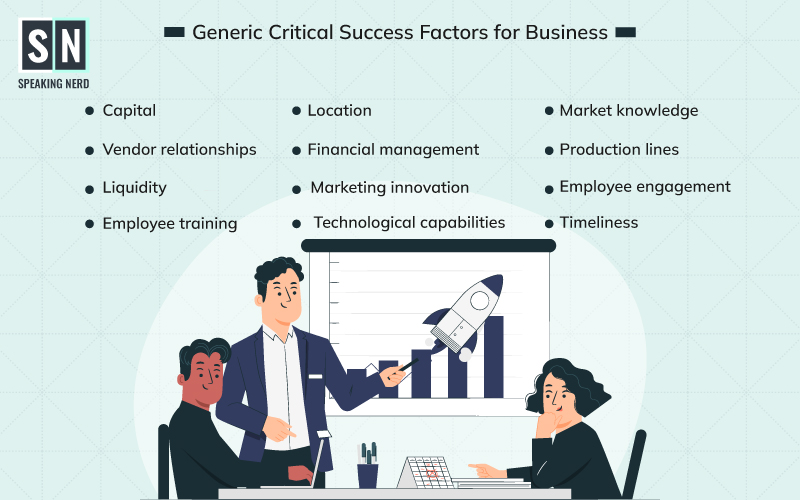
Critical success factors for business include the key factors that are more generic in nature from the purview of overall business success. Rather than being specific to individual KRAs, these success factors are salient to driving success in every vertical within an organization. In fact, these success factors may be of greater significance for new businesses or people planning to start a new business venture.
These CSFs need to be understood well for small business ideas as small businesses need to be more considerate of these CSFs than already established MNCs
Listed below are some of the most common and important examples of CSFs for business.
1. Capital
For starting a new business or expanding an established business, capital will always remain a success factor of utmost significance. Further, business capital can be further categorized into fixed capital, working capital, human capital, social capital, and other domains. If a business has the desired capital to meet a strategic plan or not will have a quintessential influence on the future course of action.
2. Location
Another key success factor for starting a new business or relocating a business is its location. The location should be such where there is the easy availability of human capital, the infrastructure is suitable for business operations and an effective supply chain is facilitated. Besides, location should be coherent with a market where the demand for the produced goods or offered services is promising enough.
3. Market knowledge
Business leaders at the helm of an emerging company or an existing company aiming for greater market penetration should have comprehensive knowledge of the market. Before strategic objectives are set into motion, it is indispensable to have good knowledge of the market so that strategic plans can be reviewed and revised. Market research and competitors’ analysis will be the key performance indicator connected to this CSF.
4. Vendor relationships
Vendor relationships form another significant success factor for businesses. Vendors include the businesses or individuals that provide services or goods to an organization. It becomes important to maintain cordial and effective vendor relationships from the viewpoint of mitigating risks, maintaining an efficient supply chain, reducing costs, and building loyalty with vendors to ensure business growth.
5.Financial management
Financial management in itself is a vast term and it is in fact, a culmination of various critical success factors. Financial management includes how well a company manages its debt, operating costs, production expenses, and supplies. Further, effective financial management involves investing finances in the right areas, negating avoidable monetary losses, and the management of employee perks and incentives.
6. Production lines
Production line refers to the linear sequences of automated and manual operations within a manufacturing unit. In the KRA of production, maintaining streamlined production lines is paramount to driving the desired production efficiency and meeting production targets.
7. Liquidity
It is imperative for a business to maintain adequate liquidity to be able to pay off the outstanding debts and short-term liabilities. To substantiate, liquidity in business is a measure of a company’s ability to translate its assets into cash with convenience and without having to incur any losses.
8. Marketing innovation
In contemporary times, marketing has become one of the most powerful dimensions of competitive advantage. Businesses are on their A-Game in terms of creativity and multichannel marketing for promoting their business in a worthwhile manner. Having said that, innovation in marketing is one of the essential success factors from the purview of brand awareness and promotion.
9. Employee engagement
Employee engagement is a measure of how committed and emotionally attached employees are to their organization. The levels of engagement among employees have a direct correlation with business success and profitability. To validate, as per Gallup, companies wherein employees are actively engaged can exhibit 22 percent higher profits than ventures with low engagement. It should be noted that employee engagement in a diverse workforce may require a strategic approach. That’s generally because diversity in a workplace demands fostering inclusion, equity, and steady HR policies.
10. Employee training
For employees to remain productive and to incorporate the latest developments and tools into their working style, employees need to undergo regular training. Besides, the onboarding training is of immense significance for new employees to understand the working of the organization and align their goals with organizational plans.
11. Technological capabilities
Automation, artificial intelligence, IoT, and other technological advancements are playing massive roles in helping businesses to scale new heights and achieve surreal results. Having said that, whether it is about setting up a new business or advancing a business further, technological capabilities will be among the paramount success factors amid this digital revolution. It would not be incorrect to say that technological infrastructure holds the key to the future of the business world.
12. Timeliness
Customer service indeed is one of the most sought-after key result areas for any business. The timeliness in terms of responding to customer queries, resolving complaints, and delivery of goods and services is a paramount critical success factor linked to this particular KRA.
B. Critical success factors for organizational change
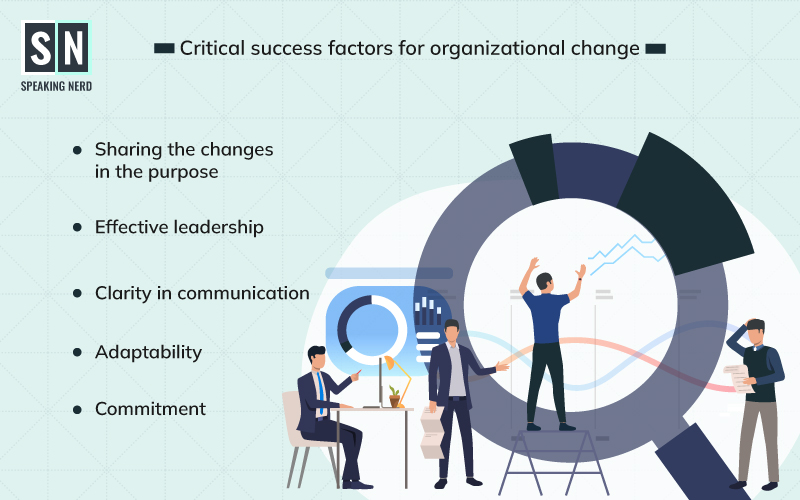
Change management is a key result area of ample significance for companies irrespective of their statute or size. In fact, in the contemporary business world that is known to be quite dynamic because of constant changes driven by external factors, intelligible change management becomes far more essential than ever before.
Some of the crucial success factors for worthwhile change management are highlighted below.
1. Sharing the changes in the purpose
One of the primary success factors for change management is to effectively share the changed purpose with all stakeholders and take them into confidence that the change is for everyone’s good. All stakeholders including employees should have clarity on what the changes are about and what they are aimed at achieving.
2. Effective leadership
The next critical success factor when it comes to organizational changes is effective leadership. Not only do leaders need to lead from the front during massive transitions but they also need to support the employees in developing understanding and comfort around the changes. It may so happen that some changes may be too overwhelming for some employees. In such a case, they would look up to their managers and leaders for support and they should be able to find it.
3. Clarity in communication
Strategic communication is a sacrosanct component of every strategic plan. Sharing the mere purpose of the change is not enough. Clearly defined goals with respect to the changes, new instructions on changing working patterns and new priorities in the organization need to be communicated to everyone concerned.
4. Adaptability
For any change big or small, it takes time for people within an organization to adapt to changes. The ability of employees as well as the top management to adapt quickly is critical to the successful implementation of organizational changes. Having said that, adaptability is undeniably a critical success factor in the KRA of change management.
5. Commitment
When colossal transitions take place within an organization, despite the turbulence that may take place, employees must remain committed to the changing organization's goals. If employees are not committed to the changes, their productivity issues will derail the pace of change management which could have serious repercussions for an organization. Having said that, for any change irrespective of the magnitude, the commitment of people within the organization is a CSF that cannot be overlooked.
C. Critical success factors for project management
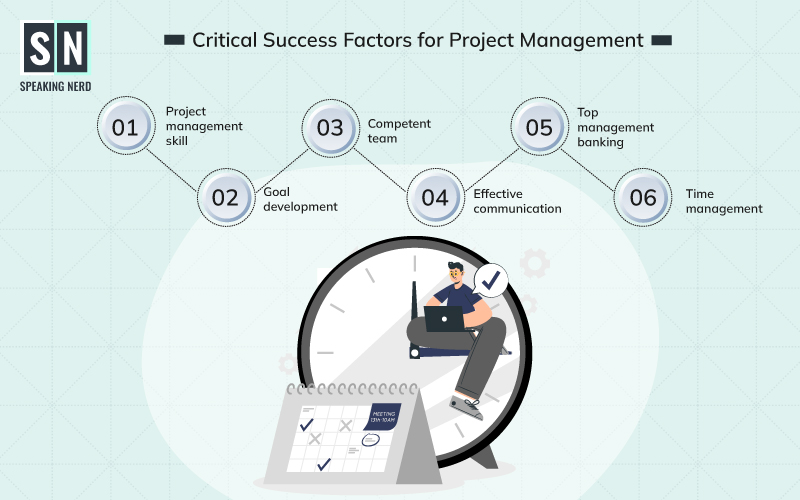
Project management is an imperative area driving in which if great results are delivered, it enables an organization to deliver successful projects. These projects include the value that an organization needs internally for success or for delivering value to customers or clients. To explain, project management involves the efficient application of skills, knowledge, methodologies, and procedures to meet strategic projects.
Needless to say, projects are delivered successfully and on time when critical success factors in project management are executed to the fullest efficiency. Some of the most important CSFs for project management are given below.
1. Skilled project managers
Project managers leading the projects should have the right amount of experience and skills needed for project management. The skills here include both hard as well as soft skills that are desired for the successful delivery of projects. It is critical to the success of a given project that the person leading it should have the prerequisite skills needed for the project.
2. Development of project goals
Another vital success factor for successful project management is to develop clear strategies for working on the project and bifurcating the project into different goals. Once the goals are developed, each person related to the project should know what is expected of them and the KPIs on which their performance will be evaluated.
3. Competent project teams
Not only the skills of the project manager but the skills of the entire team working on a project are critical to the success of the project. It is important to create competent teams keeping in view all kinds of expertise and skills needed at different levels in a project. Creating teams that lack specialization even in one vertical of the project can delay the project. Hence, you need smart teams that can deliver on SMART goals in real-time.
4. Efficient and consistent communication
It is crucial to note here that as per SalesForce, ineffective communication and collaboration are the key reasons why projects fail. In fact, 86 percent of executives and project managers cite this as the reason for failed projects. This explains how crucial efficient and consistent communication is within the project team at every stage of the project. Communication here also includes regular feedback and conveying instructions effectively for making improvements in the project.
5. Support from top management
It is highly crucial that the top management of an organization extends its complete support to the project teams. This support may be monetary in terms of funds or maybe in the form of moral and emotional support for encouragement. Support from management is critical to the morale of the team.
6. Time management
Because most projects have deadlines associated with them, time management at all levels on the part of the management, project managers, and team members is vital for success. When all goals related to a project are met on time, projects can be delivered within the stipulated time.
D. Critical success factors for product development

Under product development strategies, businesses launch new products in the existing market. The strategy is based on optimizing revenue and profitability by amplifying sales with new products. In fact, it’s a common business strategy adopted by enterprises to upscale growth. However, the success of a product development strategy depends on certain critical factors. Some key success factors that determine how well a product development strategy goes for a business are listed below.
1. Budget
Primarily, the budget allocated to the development of new products will be a crucial factor in the development of a high-quality product aimed at capturing the interest of potential customers right from the launch. Besides, the budget allocated to marketing will also play an imperative role.
2. Existing resources
If a company has adequate existing resources to introduce new products or not will be another considerable CSF for product development. If there are gaps between the existing resources and the resources needed for the development of new products, the costs will rise and profitability may still remain low.
3. Product demand
The next critical success factor in product development is demand. A product development strategy will be successful if there is high demand for new products being mulled or if there is scope for stimulating high demand. New products will only be able to upscale sales if there is sufficient demand for them among consumers.
4. 4Ps of innovation
Innovation is at the forefront of every product development strategy. The ultimate success of product development strategies is defined by the level of innovation in a business. With great innovation, a company can effectively use the existing resources and leverage the existing market to make significant gains from new products. This is where the 4Ps of innovation come in as critical success factors for product development. The 4 Ps of innovation include the following dimensions.
- Product innovation
- Process innovation
- Position innovation
- Paradigm innovation
Product, as a CSF, refers to the innovation in product features and designs. The more competitive a product is as per customer requirements the greater will be the success of product development plans. Product differentiation is also the central idea here. Secondly, the process talks about the various procedures involved in the development of new products and how innovation is applied at each step of the production process.
Moving forward, the position is a critical success factor that relates to how a product is perceived in the market or is used by the target market segment. At last, the CSF of paradigm innovation involves the paradigm shifts in business strategies with respect to shifting to other sectors that seem more profitable.
5. Product acquisition
Product acquisition can also be an important success factor for companies looking to acquire products from other manufacturers to be sold under their brand name. Product acquisition can also be in terms of acquiring the marketing or sales rights for a product from a different manufacturer. To cite an example, Ralson is an Indian tyre manufacturing company that has recently acquired the marketing rights of Dunlop tyres in India. While Ralson is an Indian brand, Dunlop is a US-based tyre manufacturer.
E. Critical success factors for construction projects
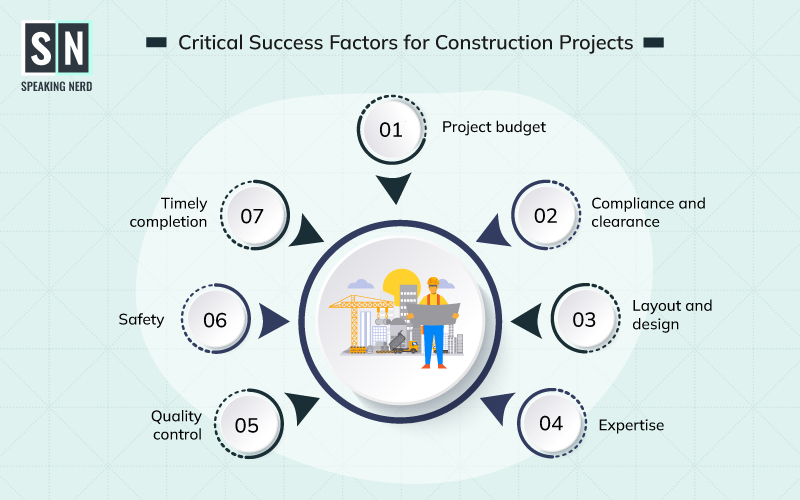
When it comes to construction projects, there is a dire need of maintaining consistency in various critical success factors given the costs and risks associated with construction. The most prominent success factors that must be considered in construction projects are given below.
1. Estimated project budget
The estimated budget of a construction project whether it is a real estate project or highway is among the leading success factors. The budget of the project determines the quality of materials to be used in the execution of a project. Also, the budget is crucial in deciding on the machinery and workforce that can be used in a given project. Budgeting facilitates the planning phase of the construction project.
2. Compliance and clearance
Another crucial success factor for construction projects is to adhere to all compliance measures and attain environmental clearance and other permissions from designated authorities. If compliance and permissions are ignored or violated, it can put the entire project at risk at a later stage.
3. Layout and design
From the planning point of view, the layout and design of the construction project are vital. The layout and design of the project will determine the area required, the number of storeys, the volumes of the crowd that can be accommodated, and the aesthetics of the project.
4. Expertise
The expertise of the architects, civil engineers, and other professionals involved in the planning and execution of the construction project will play a crucial role in the planning of the project. The higher the expertise the greater will be the success of the project.
5. Quality control
Quality control and management in terms of materials used, best practices for construction being followed and all avoiding spoilage of material during adverse weather are all imperative for the success of a construction project. High standards of quality proportionate to the budget should be maintained at all times.
6. Safety
Safety is a massive factor in any construction project as a substandard construction project can lead to loss of life in accidents. These accidents can happen in the construction phases as well as after the completion of the project. Also, the safety of workers in the course of the construction project is equally important. It is imperative to note that more than 1000 workers die per year in construction accidents in the US.
Construction remains a field with the highest number of fatalities in the US hence safety remains a critical factor for success in any construction project. Hence, workplace safety needs to be looked after at all times.
7. Timely completion
The timely completion of real estate or other construction projects is a factor directly linked to the success of a construction project. Construction projects often fail to deliver the value they commit initially because of delays and postponements.
Now that we have scrutinized the examples of some highly relevant critical success factors across different key result areas, let us shed some more light on the merits and significance of critical success factors.
Critical success factors importance
The importance of critical success factors can be expressed in terms of the advantages linked to CSFs. Of course, if we look at the larger picture, the most prominent advantage of these factors is that they ensure the success of various strategic plans and goals that are of immense value for the success of a business. However, this advantage can be further bifurcated into more specific merits to comprehend the importance of critical success factors. The highlights of the various upsides of critical success factors are given below.
1. CSFs lead to the setting of specific objectives
CSFs act as the bridge between strategic goals and business objectives. While objectives are set after goal setting in different verticals, CSFs provide complete clarity and purpose to business objectives. Having realized what factors are of utmost importance for strategic plans to succeed, companies can then set more structured and specific objectives that would integrate with each other to make a strategic plan successful. Specific objectives hold the key to utilizing the opportunities to the fullest extent as they provide a clear direction for focus and commitment.
For instance, let’s say the strategic goal of a company is to boost sales by 200 percent within a span of two years. Now, for this strategic plan, customer service will be a key result area because customer experiences lead to higher sales. Further, under this KRA, customer feedback will be a critical success factor. Knowing this, the company can set specific objectives for collecting customer feedback.
2. CSFs enable the mitigation of underperforming metrics
CSFs help the top management of a company to focus on key performance measures to drive greater business success. At the same time, CSFs also provide insights into the performance metrics that are performing below par and need to be mitigated from the strategic plans. In simpler terms, the development and monitoring of CSFs provide an opportunity to constantly tweak strategic plans and come up with new objectives and metrics for filling the gaps.
Better identification of critical success factors also helps in the recognition of factors that are not yielding the expected results. Eventually, these factors can be eradicated from the list of influences that require constant focus and commitment.
Let’s take the example of the content marketing KRA here. From the effectiveness point of view, trends in content marketing and expert insights suggest that creating more personalized content is crucial for the success of content marketing campaigns. Therefore, as more and more marketers identify this CSF, they would by default give up on creating generic content as a metric of success in content marketing. This is how CSFs help businesses stay updated with the most relevant performance metrics.
3. CSFs facilitate optimum allocation of resources
Once business leaders know which factors are the most important for success and which factors need little attention, they can effectively allocate business resources. Needless to say, companies undertake thoughtful analysis before allocating funds and other resources to success parameters.
CSFs will clearly define what the companies’ top priorities should be. A more optimum allocation of resources will of course yield greater success in strategic plans. On the other hand, the mismanagement of resources can cause performance gaps.
To cite an example, let us understand this assertion through an example linked to customer service. As per HubSpot, 93 percent of customers will make future purchases from companies that provide excellent customer service. Having said that, customer service is an important KRA for companies and customer onboarding can be a critical success factor in this domain. Knowing this, the companies can allocate more resources to customer onboarding given its immense significance.
4. CSFs reinforce company core values
Core values and principles hold overwhelming importance for most companies. These core values give a unique identity to a company which is also important for the purpose of attracting buyers. Needless to say, companies would want their objectives and actions to reflect these values strongly. This is where CSFs also help in reinforcing the company’s core values at all levels.
CSFs are inspired by the strategic goals that companies envisage from the purview of their values, vision, and mission. Given that, CSFs too reflect the core virtues that a business wants to be recognized for and these CSFs further lead to the development of objectives coherent to these values.
To exemplify, let us pay heed to the core values that Toyota reflects in its business approach. The core values of Toyota include respect, innovation, experimentation, humility, and imagination. Therefore, innovation is always at the forefront of whatever Toyota does and excellence in innovation is a CSF that Toyota strongly believes in. Based on this CSF, the company has planned the launch of 15 new vehicles driven by electricity by the end of 2025.
5. CSFs can play a massive role in boosting employee productivity
A clear sense of direction is a huge motivating factor for employees to understand their responsibilities and deliver on them. When the top management identifies CSFs effectively and communicates them to employees with efficiency, employees exactly know what metrics they need to deliver on. Working on the success factors that are crucial for the success of the company will also pave the way for their individual career advancement.
Having said that, CSFs can also help employees set individual objectives that are aligned with the overall growth of their organization. Subsequently, in an organization where there is transparent communication of strategic plans, success factors, KPIs, and objectives, employee productivity and engagement will remain high. The levels of productivity and engagement are subject to effective leadership by the top executives of the company.
To substantiate, as per HR Cloud, 85 percent of employees feel that they are more productive and motivated when their bosses share company news, priorities, success factors, and other details with them on a regular basis. This explains how critical success factors help employees in remaining coherent to the vision and mission of their company. Effective communication of critical success factors is the key. Direction empowers motivation and productivity to remain incessant.
The next section renders effective recommendations on how the critical success factors can be monitored and controlled in the best interest of an organization.
How to control CSFs
Controlling or monitoring CSFs becomes quintessential to ensure the successful implementation of factors and keep up with the pace of the dynamic nature of the modern business world. In some simple ways, you can control the success factors conveniently for consistent improvisation in business objectives.
1. Monitor CSFs regularly with relevant KPIs
As mentioned above in the process of development of CSFs, it is essential to define the key performance indicators linked to each success factor. The purpose of KPIs is to measure the performance and progression of an organization in terms of its critical success factors.
Having said that, in order to control CSFs and evaluate their contribution to the success of a company, it is recommended that KPIs are used to measure the progress of success factors on a regular basis. This will give the top management credible and quantifiable insights into which critical success factors are adding to the success of the company and which CSFs need more attention. With the assistance of key performance indicators, the CSFs can be measured and evaluated in each quarter.
2. Review the relevance of success factors
A factor that is highly crucial for business success may not be as relevant two to three years down the line. This is for the simple reason that the corporate world is quite dynamic and with more automation and innovation, changes are happening in the business landscape at a swift pace.
Hence, to control CSFs and to drive greater business success, it is critical to review the relevance of success factors that a company works around. It is true that critical success factors are subject to change with time or the external environment and companies should have the flexibility to be comfortable with these changes.
A regular review of success factors taking their contribution to company success into consideration is important. You cannot keep functioning around the same critical success factors over years as a lot of them may change or become obsolete over time.
To exemplify, if we look at recruitment practices within organizations, having a large team of recruiters may have been a critical success factor two years back. However, in contemporary times of automation and technological brilliance, inculcating artificial intelligence into recruitment processes may be a more critical success factor.
3. Plan for alternative success factors
What if your success factors do not yield the desired results in business growth? What if some success factors miserably fail to have any impact? Are you then going to undertake the entire process of developing CSFs all over again? Of course, that would lead to massive wastage of time and effort.
Hence, it is better that you plan for some alternate success factors as a part of contingency plans. When the prime success factors fail in driving success, you can immediately shift the focus to these alternative factors. This would make the company more immune to mismanagement of success factors or the wrong identification of success factors.
4. Include CSFs in performance reviews
Performance reviews and feedback sharing form imperative components of performance management. So, why not include critical success factors in sharing feedback with employees or while reviewing their performance. In the course of performance reviews, specific discussions on specific critical success factors can take place.
The focus of these discussions will be on how well employees are performing around the set success factors and the KPIs designated to them. In every performance review, the CSFs can be reviewed effectively and seniors can guide their subordinates better on ways to enhance their performance in alignment with a certain success factor. In this way, CSFs can be managed better, objectives of employees can be aligned with the organizational ambitions in a more efficient way and larger success can be driven.
To conclude, critical success factors are of immense importance for any business organization to meet its strategic goals. As explained in the definition, CSFs are the driving forces that influence the advancement of a business when they are aligned with the objectives. At the same time, ignoring critical factors for success can result in a business losing its competitive advantage. Moreover, both developing the right critical success factors and monitoring them in a diligent way hold the key to getting the maximum benefit from them. Besides, it is imperative for top executives to comprehend the relationship between KRAs, CSFs, and KPIs. The better the integration of these fundamentals the more successful a business can be.


